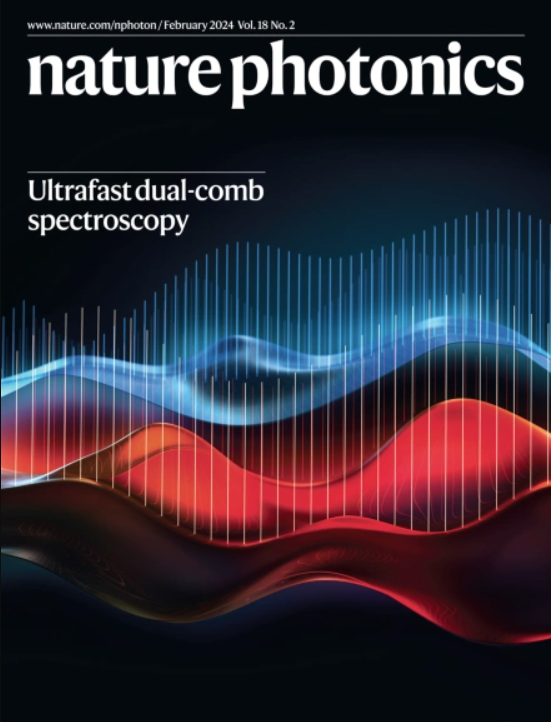硅芯片上的统一激光稳定和隔离技术
IF 32.3
1区 物理与天体物理
Q1 OPTICS
引用次数: 0
摘要
光子学的飞速发展带来了集成器件的爆炸式增长,这些器件有望在纳米尺度上提供与桌面技术相同的性能,预示着下一代光通信、传感和计量以及量子技术的到来。然而,将高性能激光系统的多个组件共同集成所面临的挑战,使这些纳米级器件的应用受到比器件本身大几个数量级的笨重激光源的阻碍。在这里,我们展示了高性能激光器的两个主要组件--降噪和隔离--可以同时来自单一的、无源的、与 CMOS 兼容的纳米光子器件,从而无需结合不兼容的技术。为了实现这一目标,我们利用高质量因子氮化硅环形谐振器的长光子寿命和非互易克尔非线性特性,对半导体激光芯片进行自注入锁定,同时提供隔离。我们还发现了当前片上激光器架构中一个以前未曾注意到的功率机制限制,而我们的系统克服了这一限制。利用我们称之为统一激光稳定器的设备,我们展示了一种内置隔离和降噪功能的片上集成激光系统,该系统运行可靠。这种方法不同于将传统激光系统组件直接微型化和集成化的努力,而是为实现完全集成的光学技术架起了一座桥梁。本文章由计算机程序翻译,如有差异,请以英文原文为准。


Unified laser stabilization and isolation on a silicon chip
Rapid progress in photonics has led to an explosion of integrated devices that promise to deliver the same performance as table-top technology at the nanoscale, heralding the next generation of optical communications, sensing and metrology, and quantum technologies. However, the challenge of co-integrating the multiple components of high-performance laser systems has left application of these nanoscale devices thwarted by bulky laser sources that are orders of magnitude larger than the devices themselves. Here we show that the two main components for high-performance lasers—noise reduction and isolation—can be sourced simultaneously from a single, passive, CMOS-compatible nanophotonic device, eliminating the need to combine incompatible technologies. To realize this, we take advantage of both the long photon lifetime and the non-reciprocal Kerr nonlinearity of a high-quality-factor silicon nitride ring resonator to self-injection lock a semiconductor laser chip while also providing isolation. We also identify a previously unappreciated power regime limitation of current on-chip laser architectures, which our system overcomes. Using our device, which we term a unified laser stabilizer, we demonstrate an on-chip integrated laser system with built-in isolation and noise reduction that operates with turnkey reliability. This approach departs from efforts to directly miniaturize and integrate traditional laser system components and serves to bridge the gap to fully integrated optical technologies. Both laser stabilization and isolation are demonstrated simultaneously by using Kerr nonlinearity in a high-Q silicon nitride ring resonator to self-injection lock a distributed-feedback laser, bringing on-chip lasers closer to real-world fully integrated applications.
求助全文
通过发布文献求助,成功后即可免费获取论文全文。
去求助
来源期刊

Nature Photonics
物理-光学
CiteScore
54.20
自引率
1.70%
发文量
158
审稿时长
12 months
期刊介绍:
Nature Photonics is a monthly journal dedicated to the scientific study and application of light, known as Photonics. It publishes top-quality, peer-reviewed research across all areas of light generation, manipulation, and detection.
The journal encompasses research into the fundamental properties of light and its interactions with matter, as well as the latest developments in optoelectronic devices and emerging photonics applications. Topics covered include lasers, LEDs, imaging, detectors, optoelectronic devices, quantum optics, biophotonics, optical data storage, spectroscopy, fiber optics, solar energy, displays, terahertz technology, nonlinear optics, plasmonics, nanophotonics, and X-rays.
In addition to research papers and review articles summarizing scientific findings in optoelectronics, Nature Photonics also features News and Views pieces and research highlights. It uniquely includes articles on the business aspects of the industry, such as technology commercialization and market analysis, offering a comprehensive perspective on the field.
 求助内容:
求助内容: 应助结果提醒方式:
应助结果提醒方式:


